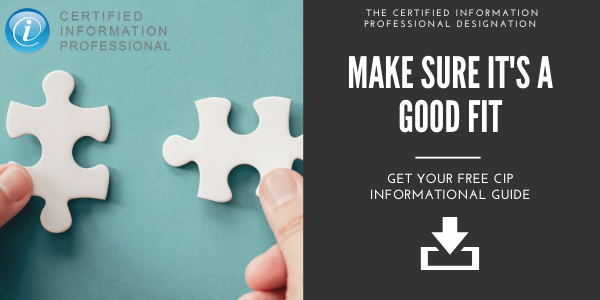
In Pursuit of the CIP: Why Did I Wait So Long?
Certified Information Professional (CIP)
I have a confession to make: I was a CIP skeptic. That’s right; I often found myself questioning whether the body of knowledge CIP represents -- even in its redesigned form -- was truly relevant for today’s information stewards in leading the digital transformation charge. I wondered whether business strategists who comprise the fastest growing AIIM membership sector would find applicability therein? Or, was CIP simply a capstone on a lifelong career for those core (and fewer) content “specialists”?
As the new president of this organization, those are particularly tough questions to have. So, last month I realized that it was high time to put my assumptions aside to pursue the darned thing. As it turns out, I did better than that; I participated in one of our in-person preparation classes led by Jesse Wilkins, CIP’s chief architect. I was joined by folks in a variety of capacities and industries, including legal, financial services, and the federal government. We discovered that, while our perceptions and experience levels were significantly different, our objectives were not. We all shared a desire to own the big picture of how information is managed and optimized in our respective organizations. Hmm, I thought, perhaps we are on to something here…
I believe that, for organizations to digitally transform, they need a much broader – and more “consumable” -- content toolkit than is traditionally represented by what we’ve known as “ECM.” Over the course of a few days, Jesse walked (make that galloped) us through six key domains of the CIP toolkit including:
- Creating and Capturing Information – users need to ingest information of all sorts and from all sources as early as possible into the process and they need to ensure that the information is optimized for machine learning and artificial intelligence;
- Organizing and Categorizing Information – metadata is the key to moving from a storage mindset to an application mindset so that workers can find information across multiple repositories and put some framework around putting that information to work in myriad ways;
- Governing Information– organizations need to remove as much of the human element from governance as possible by applying semantic and auto-classification technologies;
- Automating Information-intensive Processes– even everyday and modest processes are information-intensive, and automating them is a critical precondition to digitally transforming the business;
- Managing the Information Lifecycle– the new world of Intelligent Information Management is all about content AND data; solving the kinds of customer-centric issues confronting most organizations today requires competency in both;
- Implementing an Information Management Solution – because there are many “flavors” of information management systems, and because most organizations have many more systems and repositories than they think, careful consideration must be made to optimize current investment while seeking simpler and more customer-centric applications.
In each new chapter, we debated whether the information management concepts of traditional ECM still hold importance and meaning amidst emerging analytics and cognitive technologies like Blockchain and Hadoop. We agreed that, while the broader enterprise technology picture clearly influences the more niched content management picture, organizations (and we information stewards) still need to understand how, where, and why we must value our most important asset. Aha!
Sure, passing the exam (with flying colors, I’m proud to say) is a personal achievement. However, it is the acquisition of a solid foundation on which to grow my information management leadership that really has me jazzed. I now know that CIP isn’t the capstone of a career; it’s the cornerstone of that foundation. Digital transformation calls for digital leaders with the right skills and building blocks to optimize information assets and transform business. As a business executive, I want a CIP as the foreman of my transformation project.
About Peggy Winton
With years of program, product, and business development experience, Peggy Winton is responsible for the strategic, technical, and business direction of AIIM. Peggy believes that every organization is on – or should be on – a digital transformation journey. And, at the heart of this journey is the drive toward understanding, anticipating, and redefining internal and external customer experiences. Winton joined AIIM in January, 2002 directly from Computer Sciences Corporation (CSC), where she served as Business Developer and strategist for the Consulting Group. Prior to CSC, Winton was Vice President and Chief Operating Officer for TTM, Inc., an international firm specializing in digital and cooperative marketing programs for tourism development. She earned a Bachelor's degree fromRandolph-Macon Woman's College (now Randolph College) and a Master's degree from the University of Maryland. Winton enjoys a reputation as a persuasive and engaging communicator, cross-functional team leader, and public speaker/author.

![[Informational Guide] Is certification right for you? Get this free CIP Exam Guide to find out.](https://no-cache.hubspot.com/cta/default/332414/dcb32a30-373b-4f1b-9d7f-90425213921c.png)
